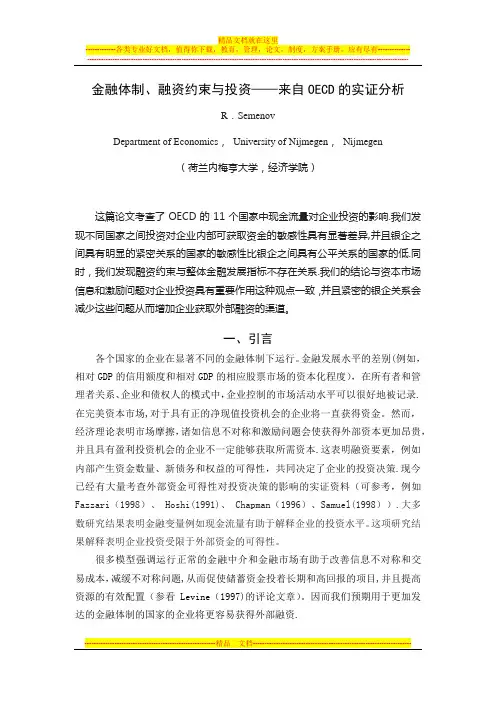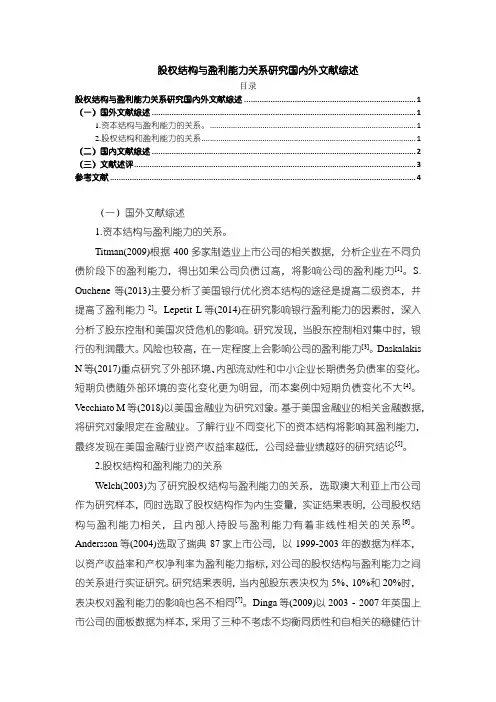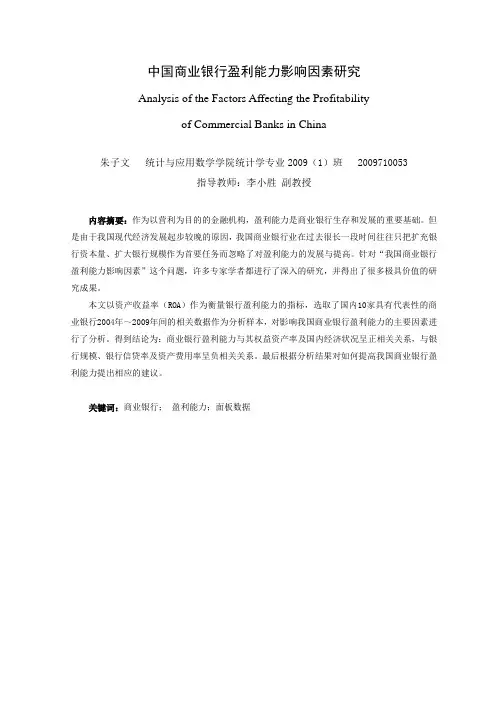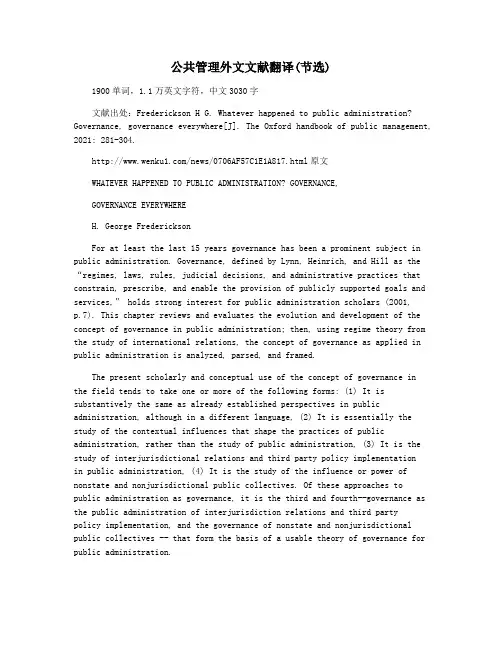外文文献翻译--欧盟国内外银行盈利能力影响因素分析(节选)
毕业论文(设计)外文文献翻译及原文

金融体制、融资约束与投资——来自OECD的实证分析R.SemenovDepartment of Economics,University of Nijmegen,Nijmegen(荷兰内梅亨大学,经济学院)这篇论文考查了OECD的11个国家中现金流量对企业投资的影响.我们发现不同国家之间投资对企业内部可获取资金的敏感性具有显著差异,并且银企之间具有明显的紧密关系的国家的敏感性比银企之间具有公平关系的国家的低.同时,我们发现融资约束与整体金融发展指标不存在关系.我们的结论与资本市场信息和激励问题对企业投资具有重要作用这种观点一致,并且紧密的银企关系会减少这些问题从而增加企业获取外部融资的渠道。
一、引言各个国家的企业在显著不同的金融体制下运行。
金融发展水平的差别(例如,相对GDP的信用额度和相对GDP的相应股票市场的资本化程度),在所有者和管理者关系、企业和债权人的模式中,企业控制的市场活动水平可以很好地被记录.在完美资本市场,对于具有正的净现值投资机会的企业将一直获得资金。
然而,经济理论表明市场摩擦,诸如信息不对称和激励问题会使获得外部资本更加昂贵,并且具有盈利投资机会的企业不一定能够获取所需资本.这表明融资要素,例如内部产生资金数量、新债务和权益的可得性,共同决定了企业的投资决策.现今已经有大量考查外部资金可得性对投资决策的影响的实证资料(可参考,例如Fazzari(1998)、 Hoshi(1991)、 Chapman(1996)、Samuel(1998)).大多数研究结果表明金融变量例如现金流量有助于解释企业的投资水平。
这项研究结果解释表明企业投资受限于外部资金的可得性。
很多模型强调运行正常的金融中介和金融市场有助于改善信息不对称和交易成本,减缓不对称问题,从而促使储蓄资金投着长期和高回报的项目,并且提高资源的有效配置(参看Levine(1997)的评论文章)。
因而我们预期用于更加发达的金融体制的国家的企业将更容易获得外部融资.几位学者已经指出建立企业和金融中介机构可进一步缓解金融市场摩擦。
国外书籍关于盈利能力的研究

国外书籍关于盈利能力的研究在当今经济全球化的背景下,盈利能力成为企业、投资者以及学者们关注的焦点。
国外有许多优秀的书籍对此进行了深入研究,为我们提供了丰富的理论资源。
本文将介绍几本关于盈利能力研究的国外书籍,帮助读者更好地理解这一领域。
一、《盈利能力分析:企业价值最大化的艺术》作者:肯尼斯·普瑞斯(Kenneth C.Prince)本书详细介绍了盈利能力分析的方法和技巧,旨在帮助企业实现价值最大化。
书中通过大量的实际案例,阐述了盈利能力对企业发展的重要性,并提供了实用的盈利能力评估工具。
此外,书中还讨论了如何通过提高盈利能力来优化企业战略和决策。
二、《企业盈利能力:理论、实践与案例》作者:詹姆斯·C.范霍恩(James C.Van Horne)本书深入探讨了企业盈利能力的理论基础和实践方法,通过丰富的案例,分析了影响企业盈利能力的内外部因素。
书中还介绍了盈利能力预测和评估的模型,为企业制定盈利策略提供了有力的理论支持。
三、《盈利能力与公司治理:国际视角》作者:马克·J.罗斯(Marc J.Roos)本书从国际视角分析了盈利能力与公司治理之间的关系。
作者通过对多个国家和地区的实证研究,揭示了公司治理结构对盈利能力的影响。
书中还提出了改善公司治理、提高盈利能力的策略和建议。
四、《盈利能力、投资与经济增长》作者:阿夫纳·伯恩斯坦(Avner Barnea)和罗恩·D.费尔德曼(Ron D.Feldman)本书研究了盈利能力、投资与经济增长之间的关系。
作者认为,提高盈利能力是促进企业投资和经济增长的关键因素。
书中还讨论了如何通过政策调整和改革来优化资源配置,进而提高盈利能力和经济增长。
五、《盈利能力、竞争与市场结构》作者:迈克尔·E.波特(Michael E.Porter)本书从竞争战略的角度分析了盈利能力与市场结构的关系。
作者提出了著名的“五力模型”,并在此基础上探讨了如何通过市场竞争来提高企业的盈利能力。
《股权结构与盈利能力关系研究国内外文献综述3500字》

股权结构与盈利能力关系研究国内外文献综述目录股权结构与盈利能力关系研究国内外文献综述 (1)(一)国外文献综述 (1)1.资本结构与盈利能力的关系。
(1)2.股权结构和盈利能力的关系 (1)(二)国内文献综述 (2)(三)文献述评 (3)参考文献 (4)(一)国外文献综述1.资本结构与盈利能力的关系。
Titman(2009)根据400多家制造业上市公司的相关数据,分析企业在不同负债阶段下的盈利能力,得出如果公司负债过高,将影响公司的盈利能力[1]。
S. Ouchene等(2013)主要分析了美国银行优化资本结构的途径是提高二级资本,并提高了盈利能力2]。
Lepetit L等(2014)在研究影响银行盈利能力的因素时,深入分析了股东控制和美国次贷危机的影响。
研究发现,当股东控制相对集中时,银行的利润最大。
风险也较高,在一定程度上会影响公司的盈利能力[3]。
Daskalakis N等(2017)重点研究了外部环境、内部流动性和中小企业长期债务负债率的变化。
短期负债随外部环境的变化变化更为明显,而本案例中短期负债变化不大[4]。
Vecchiato M等(2018)以美国金融业为研究对象。
基于美国金融业的相关金融数据,将研究对象限定在金融业。
了解行业不同变化下的资本结构将影响其盈利能力,最终发现在美国金融行业资产收益率越低,公司经营业绩越好的研究结论[5]。
2.股权结构和盈利能力的关系Welch(2003)为了研究股权结构与盈利能力的关系,选取澳大利亚上市公司作为研究样本,同时选取了股权结构作为内生变量,实证结果表明,公司股权结构与盈利能力相关,且内部人持股与盈利能力有着非线性相关的关系[6]。
Andersson等(2004)选取了瑞典87家上市公司,以1999-2003年的数据为样本,以资产收益率和产权净利率为盈利能力指标,对公司的股权结构与盈利能力之间的关系进行实证研究。
研究结果表明,当内部股东表决权为5%、10%和20%时,表决权对盈利能力的影响也各不相同[7]。
中国商业银行盈利能力影响因素研究

中国商业银行盈利能力影响因素研究Analysis of the Factors Affecting the Profitabilityof Commercial Banks in China朱子文统计与应用数学学院统计学专业2009(1)班 2009710053指导教师:李小胜副教授内容摘要:作为以营利为目的的金融机构,盈利能力是商业银行生存和发展的重要基础。
但是由于我国现代经济发展起步较晚的原因,我国商业银行业在过去很长一段时间往往只把扩充银行资本量、扩大银行规模作为首要任务而忽略了对盈利能力的发展与提高。
针对“我国商业银行盈利能力影响因素”这个问题,许多专家学者都进行了深入的研究,并得出了很多极具价值的研究成果。
本文以资产收益率(ROA)作为衡量银行盈利能力的指标,选取了国内10家具有代表性的商业银行2004年~2009年间的相关数据作为分析样本,对影响我国商业银行盈利能力的主要因素进行了分析。
得到结论为:商业银行盈利能力与其权益资产率及国内经济状况呈正相关关系,与银行规模、银行信贷率及资产费用率呈负相关关系。
最后根据分析结果对如何提高我国商业银行盈利能力提出相应的建议。
关键词:商业银行;盈利能力;面板数据Abstract: As to the financial institutions for the purpose of profit, profit ability is an important foundation for the survival and development of commercial banks. But due to a late start of modern economic development in China, China's commercial banks for a long time in the past often only to overcharge bank capital, expand the scale of banks as the primary task and ignore the development and improvement of profitability. According to the "factors" the profitability of China's commercial banks influence the problem, many experts and scholars have conducted in-depth research, and obtained many valuable research results.In this paper, return on assets (ROA) as a measure of bank profitability index, the paper selects 10 representative commercial banks in 2004 to 2009 years relevant data as sample for analysis on the main factors affecting the profitability of commercial banks in China are analyzed. The conclusion is: the correlation between the profitability of commercial banks and equity ratio and the domestic economic situation positively, negatively correlates with the size of the bank, the bank credit rate and asset cost rate. Finally, according to results of the analysis of how to improve the profitability of commercial banks in China and put forward the corresponding suggestion.Keywords: Commercial Bank;Profitability;Panel data目录1.引言 (1)1.1研究意义 (1)1.2我国商业银行现状 (1)2. 文献综述 (2)2.1我国学者对商业银行盈利能力的研究 (2)2.2本文的研究特点 (2)3. 指标的选取 (3)3.1指标的选取原则 (3)3.2指标的选取 (3)4. 数据来源及研究方法介绍 (4)4.1数据来源 (4)4.2研究方法介绍 (4)5. 面板模型介绍 (5)5.1面板数据模型解析 (5)5.2面板模型的分类 (5)6.实证分析 (5)6.1实证分析步骤 (5)6.2实证分析结果 (8)7.实证结论分析 (8)7.1银行规模对商业银行盈利能力的影响 (8)7.2银行信贷率对对商业银行盈利能力的影响 (9)7.3权益资产率对商业银行盈利能力的影响 (9)7.4资产费用率对商业银行盈利能力的影响 (9)7.5国内经济状况对商业银行盈利能力的影响 (9)8.建议 (10)9.附言 (10)参考文献 (11)1.引言商业银行作以营利为目的的金融机构,盈利能力是其在经营过程中应当考虑的首要指标,对其生存和发展起到了至关重要的作用。
盈利能力的国外文献综述

盈利能力的国外文献综述
随着全球化和国际化的发展,越来越多的企业开始关注盈利能力。
本文综述了国外关于盈利能力的研究,包括其定义、测量方法、影响因素和管理策略等方面。
首先,盈利能力被定义为企业在特定时期内所获得的净利润或利润率。
这一概念通常被用来衡量企业获得经济利益的能力。
其次,盈利能力的测量方法包括利润率、ROE、ROI等指标。
利
润率是企业的净利润与总收入之比,ROE是企业净利润与股东权益之比,ROI是企业净利润与总资产之比。
这些指标可以帮助企业了解其盈利能力的状况,并作出相应的调整。
影响盈利能力的因素包括市场竞争、成本控制、营销策略、资本结构等。
企业需要通过不断优化这些因素来提高其盈利能力。
最后,管理策略是提高盈利能力的关键。
这包括制定合理的财务计划、设定有挑战性但可实现的利润目标、优化营销策略、控制成本等。
同时,企业还需要注重员工培训和创新,以提高企业的竞争力和市场占有率。
总之,盈利能力是企业发展的重要指标之一。
通过合理的测量和管理,在竞争激烈的市场环境中提高盈利能力是企业取得成功的关键。
- 1 -。
公共管理外文文献翻译(节选)

公共管理外文文献翻译(节选)1900单词,1.1万英文字符,中文3030字文献出处:Frederickson H G. Whatever happened to public administration? Governance, governance everywhere[J]. The Oxford handbook of public management, 2021: 281-304./news/0706AF57C1E1A817.html原文WHATEVER HAPPENED TO PUBLIC ADMINISTRATION? GOVERNANCE,GOVERNANCE EVERYWHEREH. George FredericksonFor at least the last 15 years governance has been a prominent subject in public administration. Governance, defined by Lynn, Heinrich, and Hill as the “regimes, laws, rules, judicial decisions, and administrative practices that constrain, prescribe, and enable the provision of publicly supported goals and services,” holds strong interest for public administration scholars (2001,p.7). This chapter reviews and evaluates the evolution and development of the concept of governance in public administration; then, using regime theory from the study of international relations, the concept of governance as applied in public administration is analyzed, parsed, and framed.The present scholarly and conceptual use of the concept of governance inthe field tends to take one or more of the following forms: (1) It is substantively the same as already established perspectives in public administration, although in a different language, (2) It is essentially the study of the contextual influences that shape the practices of public administration, rather than the study of public administration, (3) It is the study of interjurisdictional relations and third party policy implementationin public administration, (4) It is the study of the influence or power of nonstate and nonjurisdictional public collectives. Of these approaches topublic administration as governance, it is the third and fourth--governance as the public administration of interjurisdiction relations and third partypolicy implementation, and the governance of nonstate and nonjurisdictional public collectives -- that form the basis of a usable theory of governance for public administration.It was Harlan Cleveland who first used the word “governance” as an alternative to the phrase public administration. In the mid-1970s, one of the themes in Cleveland's particularly thoughtful and provocative speeches, papers, and books went something likethis: “What the people want is less government and more governance” (1972). What he meant by governance was the following cluster of concepts.In all, Rhodes (2000, pp. 55-60) found seven applications of governance in the field of public administration: the new public management or managerialism; good governance, as in efficiency, transparency, meritocracy, and equity; international and interjurisdictional interdependence; non-government driven forms of socio-cybernetic systems of governance; the new political economy, including shifting from state service provision to the state as regulator; and networks. There are many more applications of governance to the subject once known as public administration, but these few illustrate the capacious rangeof concepts, ideas, and theories associated with it.There are as many definitions of the concept of governance as a synonymfor public administration as there are applications. Kettl claims an emerging gap between government and governance. \institutions. Governance is the way government gets its job done.如何翻译外文文献Traditionally, government itself managed most service delivery. Toward the end of the twentieth century, however, government relied increasingly on non-governmental partners to do its work, through processesthat relied less on authority for control\xi). To Kettl, governance, as an approach to public administration, has primarily to do with contracting-outand grants to sub-governments.As was noted at the outset, Lynn, Heinrich, and Hill (2001 p. 15) use a much bigger approach to governance as an analytic framework. Their model, intended to be a starting point for research, is: O = f [E, C, T, S, M] Where:O = Outputs/outcomes. The end product of a governance regime. E = Environmental factors. These can include political structures, levels ofauthority, economic performance, the presence or absence of competition among suppliers, resource levels and dependencies, legal framework, and the characteristics of a target population.C = Client characteristics. The attributes, characteristics, and behaviorof clients. T = Treatments. These are the primary work or core processes ofthe organizations within thegovernance regime. They include organizational missions and objectives, recruitment and eligibility criteria, methods fro determining eligibility, and program treatments or technologies.S = Structures. These include organizational type, level of coordination and integration among the organizations in the governance regime, relative degree of centralized control, functional differentiation, administrativerules or incentives, budgetary allocations, contractual arrangements or relationships, and institutional culture and values.M = Managerial roles and actions. This includes leadership characteristics, staff- management relations, communications, methods of decision-making, professional/career concerns, and mechanisms of monitoring, control, and accountability.The problem is that it is difficult, following Lynn, Heinrich, and Hill,to conceive of anything involving government, politics, or administration that is not governance. That being the case, there appears to be little difference between studying the whole of government and politics and studying public administration. Put another way, public administration is ordinarily thoughtto have to do with “treatments,” “structures,” and “management” in the Lynn, et al. governance formula. They tuck the centerpieces of public administration into the broader context of governance. This chapter will later return to these distinctions and to a large-scale synthesis of governance research by Lynn, Heinrich and Hill.Concepts of governance as public administration reflect a long-standing theoretical debate in the field, the matter of distinctions between politics, and policy on one hand and policy implementation or administration on the other. Easy dismissal of the politics-administration dichotomy serves to focus the study of public administration, particularly by some governance theorist, on the constitutional and political context of the organization and management of the territorial state or jurisdiction. From this perspective governance becomes steering and public administration becomes rowing, a lesser phenomenon in the scholarly pecking order, not to mention a lesser subject in governance. Public administration, thus understood, is the work that governments contract-out, leaving governance as the subject of our study. Although the linesbetween politics, policy, and administration are often fuzzy and changing, and although we know, strictly speaking, there is not a politics- administration dichotomy, is nevertheless important to understand the empirical distinctions between political and administrative phenomena. Concepts of governance that advance our understanding of public-sector administrationand organization are helpful. Concepts of governance that simply change the subject of public administration to politics and policy making are not. In democratic government it is, after all, elected officials who govern. Bureaucrats have roles and responsibilities for governing or governance, butin democratic polities these roles and responsibilities are different than the roles and responsibilities of elected officials. Janet Newman says it well: “Neither”good governance“nor” well-managed government could resolve the contradictions around the popular role of government and the appropriate boundaries of governance” (2001 p. 170). In the name of stamping out bureaucracy and replacing it with what they describe as good governance, Osborne and Gaebler advocate a range of managerial prerogatives that would significantly intrude on the political and policy-making prerogatives generally assumed to belong to elected officials, and particularly elected legislators, in a democratic polity (1992).The second implication of the critique is that governance theoristspersist in looking for an all-pervasive pattern of organizational and administrative behavior, a \theory\that will provide an explanation for the past and a means to predict the future. Despite the accumulated evidence based on decades of work on theory and the empirical testing of theory in public administration, no such pattern has been found (Frederickson and Smith 2021). Does the governance concept beguile a generation of scholars to set off in the vain search for a metatheoretical El Dorado (Olsen 2021)?Constructing a Viable Concept of Governance for Public Administration Although the critique of governance is a serious challenge, does it render the concept useless? The answer is no. There are powerful forces at work in the world, forces that the traditional study of politics, government, and public administration do not explain. The state and its sub-jurisdictions are losing important elements of their sovereignty; borders have less and less meaning. Social and economic problems and challenges are seldom contained within jurisdictional boundaries, and systems of communication pay little attention to them. Business is increasingly regional or global. Business elites have multiple residences and operate extended networks that are highly multi-jurisdictional. States and jurisdictions are hollowing-out their organization and administrative capacities, exporting to contractors much of the work of public administration. Governance, even with its weakness, is the most useful available concept for describing and explaining these forces. But for governance to become anything more than passing fashion or a dismissive un-public administration, it must respond to the critique of governance. To dothis, governance scholars must settle on an agreed- upon definition, a definition broad enough to comprehend the forces it presumes to explain but not so broad as to claim to explain everything. Governance theorists must be ready to explain not only what governance is, but also what it is not. Governance theorist must be up-front about the biases in the concept and the implications of those biases.The lessons learned in the evolution of regime theory in international relations are relevant here because regime theory predates governance theory and because the two are very nearly the same thing. Summing-UpFrom its prominence in the 1980s, regime theory would now be described as one of many important theories of international relations. International relations is, of course, the study of relations between nation-states whereas public administration is the study of the management of the state and its subgovernments. It could be said that regime theory accounts for the role of non-state actors and policy entrepreneurs in the context of the modern transformation of the nation-state. In public administration it could be said that the modern transformation of states and their subgovernments explains the contemporary salience of theories of governance. Both regime theory and governance theory are scholarly responses to the transformation of states.Government in the postmodern state involves multiple levels of interlocked and overlapping arenas of collective policy implementation. Governments now operate in the context of supranational, international, transgovernmental and transnational relations in elaborate patterns of federated power sharing and interdependence. Therefore, it is now understood that public administration as governance is the best description of the management of the transformed or postmodern state (Sorensen 2021) Nationhood and community are transformed as collective loyalties are increasingly projected away from the state. Major portions of economic activity are now embedded in cross-border networks and national and local economies are less self-sustaining that they once were (Sorensen 2021, p. 162)Harlan Cleveland understood very early how governments, economies and communities were changing and how rapidly they were changing. His initial description of public administration as governance was designed to square the theory and practices of the field with the realities of a changing world. His governance model still serves as a感谢您的阅读,祝您生活愉快。
商业银行盈利能力及影响因素分析
商业银行应建立健全风险管理机制,完善风险评估、监测、预警和应对体系。同时,加强内部控制和合规管理, 防范操作风险和道德风险。此外,商业银行还应提高风险管理人员的专业素质,加强风险管理的信息化建设。
推进金融创新,提升金融服务水平
总结词
推进金融创新,提升金融服务水平,有助于提高商业银行的 盈利能力。
B
C
D
监管政策限制
我国商业银行在监管政策方面受到较多限 制,例如存贷比限制、资本充足率要求等 ,对盈利能力产生了一定的影响。
人才和技术落后
我国商业银行在人才和技术方面相对落后 ,缺乏高素质的专业人才和先进的技术支 持。
05
提高我国商业银行盈利能力的 对策建议
优化资产结构,降低不良贷款率
总结词
通过优化资产结构,降低不良贷款率,可以提高商业银行的盈利能力。
净利息收益率
净利息收益率是我国商业银行的主要收入来 源,但近年来呈下降趋势。
非利息收入占比
我国商业银行的非利息收入占比普遍较低, 表明业的比较
资本充足率
01
我国商业银行的资本充足率普遍低于国际同业水平,表明风险
抵御能力较弱。
成本收入比
02
我国商业银行的成本收入比普遍较高,表明成本控制能力较弱
资产质量的好坏直接影响银行的盈利能力 ,不良贷款率、逾期贷款率等指标都会对 银行的盈利能力产生影响。
业务结构
管理能力
银行的业务结构也会影响其盈利能力,如 贷款、存款、投资等业务的比例,以及中 间业务的占比等。
银行的管理能力,包括风险管理、内部控 制、财务管理等方面的能力,都会对银行 的盈利能力产生影响。
商业银行盈利能力及影响因 素分析
汇报人: 2024-01-02
欧盟财务状况分析报告(3篇)
第1篇一、引言欧盟(European Union,简称EU)是世界上最大的经济体之一,由28个成员国组成,其经济总量和影响力在全球范围内具有重要地位。
随着全球经济的不断发展,欧盟的财务状况备受关注。
本报告将对欧盟的财务状况进行详细分析,包括财政收入、支出、债务等方面,以期为我国相关决策提供参考。
二、欧盟财政收支概况1. 财政收入欧盟的财政收入主要来源于以下几个方面:(1)成员国缴纳的会费:欧盟会费是欧盟财政的主要收入来源,占欧盟财政收入的约80%。
会费缴纳标准根据各成员国的国内生产总值(GDP)和人口等因素确定。
(2)关税和进口税:欧盟对进口商品征收关税和进口税,这部分收入占欧盟财政收入的约10%。
(3)增值税:欧盟内部增值税是欧盟财政的重要收入来源,占欧盟财政收入的约10%。
(4)其他收入:包括罚款、利息收入等,占欧盟财政收入的约10%。
2. 财政支出欧盟的财政支出主要包括以下几个方面:(1)农业补贴:农业补贴是欧盟财政支出的重要组成部分,主要用于支持欧盟农业发展和农民利益。
(2)区域发展基金:区域发展基金用于支持欧盟内部欠发达地区的经济发展,缩小地区发展差距。
(3)社会保障:社会保障支出包括养老保险、失业保险、医疗保险等,占欧盟财政支出的约30%。
(4)其他支出:包括教育、科研、环境保护、外交、安全等领域支出。
三、欧盟债务状况1. 债务规模截至2020年底,欧盟债务总额达到约7.5万亿美元,占欧盟GDP的约80%。
其中,欧元区债务总额约为6.6万亿美元,占欧元区GDP的约88%。
2. 债务结构欧盟债务主要分为以下几类:(1)公共债务:包括政府债务和地方政府债务,占欧盟债务总额的约70%。
(2)私营部门债务:包括银行、企业等私营部门债务,占欧盟债务总额的约30%。
(3)家庭债务:家庭债务占欧盟债务总额的约10%。
3. 债务风险欧盟债务风险主要体现在以下几个方面:(1)债务水平较高:欧盟债务水平较高,容易引发债务危机。
外文文献翻译【欧盟国内外银行盈利能力影响因素分析】
1外文资料翻译译文欧盟国内外银行盈利能力影响因素分析摘要:本文使用银行级数据,通过1995 - 2001年期间国内和外国银行在15个欧盟国家的商业运营情况来了解银行的具体特点和整体银行业环境对影响盈利能力。
结果表明, 国内和外国银行的盈利能力不仅受银行具体特点的影响,也受金融市场结构和宏观经济条件的影响。
除了在集中情况下国内银行利润, 所有的变量都是有重大意义的,尽管它们的影响和关系对国内和国外银行并不总是相同。
1 介绍在过去的几年许多的因素造成了欧盟银行业竞争日益激烈。
最重要的因素之一是针对服务、建立、运行和监督信贷机构的第二个欧洲指令出台,在银行和金融领域放松管制。
这个指令为所有欧洲银行机构在单一欧洲金融市场和提供了平等的竞争条件,因此银行正在先前无法预料的国内外竞争之中。
另外, 最近一些的技术进步对规模经济和范围提供了更多的机会,而采用欧元也加速了行业的变化。
此外,宏观经济政策后大多数国家通货膨胀率和利率逐步降低。
最后,在越来越多的欧洲国家非金融公司被允许提供传统的银行服务,并且在竞争中进一步提高,银行被迫产生新的产品和寻找新客户。
许多银行为了参加欧洲市场和银行业扩大被迫增加规模,通过合并和收购的方式进行了前所未有的整合。
在环境快速变化的情况下,这些变化给在欧盟的银行带来很大的挑战,因此影响了他们的效能。
格林指出,充足的收益是必要的条件让银行保持偿付能力,在一个合适的环境生存、发展和繁荣。
考虑到银行业的健康发展和经济知识增长,影响银行的盈利能力的潜在因素不仅和管理者有关,而且和众多利益相关者如中央银行,银行家协会、政府以及其他金融当局有关。
2 文献综述参考文献与本文可分为三大类。
第一部分是研究集中于银行的盈利能力的决定因素。
第二部分包括研究欧洲银行的利润和成本效率。
第三由研究比较国内外银行。
在下面几个部分中,我们讨论这些类别中的每一个。
3 决定因素和变量选择3.1 因变量本研究使用平均资产回报率(ROAA)来评估银行的性能。
《2024年城市商业银行盈利能力影响因素实证研究》范文
《城市商业银行盈利能力影响因素实证研究》篇一一、引言随着中国金融市场的日益开放和竞争加剧,城市商业银行作为我国金融体系的重要组成部分,其盈利能力的研究显得尤为重要。
本文旨在通过实证研究,深入探讨影响城市商业银行盈利能力的关键因素,以期为提升其经营效率和竞争力提供理论支持。
二、研究背景及意义近年来,城市商业银行在服务地方经济、支持中小企业发展等方面发挥着重要作用。
然而,随着金融市场的开放和外资银行的进入,城市商业银行面临着巨大的竞争压力。
因此,研究其盈利能力的影响因素,对于提高其经营效率、增强竞争力具有重要意义。
三、文献综述前人关于商业银行盈利能力的研究主要集中在资本充足率、资产质量、风险控制、服务质量等方面。
研究表明,这些因素对商业银行的盈利能力具有显著影响。
然而,由于各地区、各银行之间的差异,这些影响因素的具体作用机制和程度可能存在差异。
因此,本文以城市商业银行为研究对象,进一步探讨其盈利能力的影响因素。
四、研究方法与数据来源本文采用实证研究方法,以我国城市商业银行为研究对象,收集相关数据,运用统计软件进行分析。
数据来源主要包括各银行年报、银监会公布的数据以及相关研究报告。
五、实证研究1. 变量选择与模型构建本文选取资本充足率、资产质量、风险控制、服务质量、宏观经济因素等作为影响因素,以城市商业银行的净资产收益率(ROE)为被解释变量,构建多元线性回归模型。
2. 描述性统计分析通过对各变量进行描述性统计分析,发现城市商业银行的资本充足率、资产质量等指标存在较大差异,这可能与其盈利能力存在一定关系。
3. 实证结果分析通过多元线性回归分析,发现资本充足率、资产质量、风险控制和服务质量对城市商业银行的盈利能力具有显著影响。
其中,资本充足率和资产质量对盈利能力具有正向影响,而风险控制则对盈利能力具有负向影响。
此外,宏观经济因素如GDP增长率、市场利率等也对城市商业银行的盈利能力产生影响。
六、讨论与结论1. 讨论本文研究表明,资本充足率、资产质量、风险控制和服务质量是影响城市商业银行盈利能力的重要因素。
- 1、下载文档前请自行甄别文档内容的完整性,平台不提供额外的编辑、内容补充、找答案等附加服务。
- 2、"仅部分预览"的文档,不可在线预览部分如存在完整性等问题,可反馈申请退款(可完整预览的文档不适用该条件!)。
- 3、如文档侵犯您的权益,请联系客服反馈,我们会尽快为您处理(人工客服工作时间:9:00-18:30)。
中文2474字1外文资料翻译译文欧盟国内外银行盈利能力影响因素分析摘要:本文使用银行级数据,通过1995 - 2001年期间国内和外国银行在15个欧盟国家的商业运营情况来了解银行的具体特点和整体银行业环境对影响盈利能力。
结果表明, 国内和外国银行的盈利能力不仅受银行具体特点的影响,也受金融市场结构和宏观经济条件的影响。
除了在集中情况下国内银行利润, 所有的变量都是有重大意义的,尽管它们的影响和关系对国内和国外银行并不总是相同。
1 介绍在过去的几年许多的因素造成了欧盟银行业竞争日益激烈。
最重要的因素之一是针对服务、建立、运行和监督信贷机构的第二个欧洲指令出台,在银行和金融领域放松管制。
这个指令为所有欧洲银行机构在单一欧洲金融市场和提供了平等的竞争条件,因此银行正在先前无法预料的国内外竞争之中。
另外, 最近一些的技术进步对规模经济和范围提供了更多的机会,而采用欧元也加速了行业的变化。
此外,宏观经济政策后大多数国家通货膨胀率和利率逐步降低。
最后,在越来越多的欧洲国家非金融公司被允许提供传统的银行服务,并且在竞争中进一步提高,银行被迫产生新的产品和寻找新客户。
许多银行为了参加欧洲市场和银行业扩大被迫增加规模,通过合并和收购的方式进行了前所未有的整合。
在环境快速变化的情况下,这些变化给在欧盟的银行带来很大的挑战,因此影响了他们的效能。
格林指出,充足的收益是必要的条件让银行保持偿付能力,在一个合适的环境生存、发展和繁荣。
考虑到银行业的健康发展和经济知识增长,影响银行的盈利能力的潜在因素不仅和管理者有关,而且和众多利益相关者如中央银行,银行家协会、政府以及其他金融当局有关。
2 文献综述参考文献与本文可分为三大类。
第一部分是研究集中于银行的盈利能力的决定因素。
第二部分包括研究欧洲银行的利润和成本效率。
第三由研究比较国内外银行。
在下面几个部分中,我们讨论这些类别中的每一个。
3 决定因素和变量选择3.1 因变量本研究使用平均资产回报率(ROAA)来评估银行的性能。
ROAA是把净利润表示为一个百分比的平均总资产。
它显示了每欧元资产获得的利润并指明如何有效的银行的资产去设法创造收益。
平均资产是用来在会计年度中发现发现资产上的任何差异。
Golin(2001)指出,平均资产回报率是衡量盈利能力的关键。
3.2 决定因素和独立变量四个银行特征用作内部决定因素。
这些都是银行的总资产、成本收入比、权益与资产比率和银行的贷款的比率除以客户和短期融资。
此外,六个外部因素是用来检查环境的影响对银行的表现。
4 数据和方法我们的示例是一个平衡面板数据集,由在15个欧盟国家的584家商业银行从1995 - 2001年期间的4088组数据组合而成。
表2和表3分别展示了目前银行的数量所属的国家和所有权和样本特征。
5 实证结果表4报告对银行的平均资本回报率(ROAA)的实证估计。
第一列体现了把所有的银行(584)同时考虑的结果。
第二、三列体现了我们通过银行经营这所属的国家把银行分离出来的结果。
我们定义一个银行是国外还是国内是依靠外国人的股份资本是否超过50%,这个子样本包括332家国内银行和218家外资银行。
在这个阶段,约34个银行被排除在分析,由于我们没有足够的信息来辨别其是国内还是国外。
除了在集中情况下国内银行平均资本回报率,所有的变量都是显著的,尽管它们对国内外银行的平均资本回报率的影响和关系并不总是相同的。
这个模型的解释力对国内银行是更高的(调整R2国内银行等于0.6371,而外资银行等于0.3903),而f统计所有模型的重要性在1%的水平。
这意味着额外的因素可能会影响外国银行的盈利能力。
像威廉姆斯(2003)正确地指出,外资银行运行在一个受两个因素影响的主机市场,分别是他们是属于外国跨国银行和他们的参与银行系统的主机。
由比较高的显着系数的股权资产(EQAS)和成本收入比(COST)显示,在一般情况下,平均资产回报率的主要决定因素是资本实力及费用管理效率。
股权资产与平均资本成本是正相关关系,无论我们考察国内银行还是国外的银行,而且它是国内银行盈利能力是最重要的决定因素。
这一调查结果与以往的调查研究是一致的,资本充足的银行在破产和规模缩减方面面临着较低的成本,因此,它们的融资成本比较低或具有较低的外部资金的需求,促成了较高的盈利能力。
成本收入比(COST)被预期是外资银行盈利能力的最重要的决定因素,是正如预期的那样的,呈现出负相关关系,这些费用的增加会在很大程度上减少在欧盟银行的经营利润。
很多学者也发现了费用管理不善是盈利能力差的主要因素。
因此,在欧盟的商业银行应采取必要的行动,以实现更有效的成本控制,以进一步增加他们的利润。
外国(-0.309)和国内银行(-0.144)之间的系数的差异可能是由于不当的管理操作以及与监测机构存在的距离。
关于流动性,结果是喜忧参半。
客户的净贷款及短期资金比率(LOFUND)在统计上显着,并与国内银行的盈利能力呈正相关,表明银行流动性资产持有量水平和盈利能力水平呈负相关关系,与预料的一样。
对于外资银行来说,变量也很显着,但有一个负号,说明流动性和银行利润的正相关关系,出乎我们的意料,虽然与伯克(1989)和Kosmidou(2006)的研究一致。
无论是国内或国外银行,规模(SIZE)之间的关系和银行的业绩是负的。
负系数表明,在这两种银行中,大银行的收入水平就会低于的利润,研究也发现要么经济规模和范围为较小的银行或金融机构的规模不够大。
范德Vennet(1998)发现的证据表明,在欧盟规模经济效益只有在根据资产小于10亿欧元的最小银行才有效,此后报酬不变和规模不经济的最大银行超过1000欧亿。
6 结语在最近几年中,许多因素加剧了欧盟银行业的竞争,尤其是银行的操作环境的急速变化给银行带来了巨大的挑战。
这是合理的假设去认为所有这些变化都必然会对银行的表现有一定的影响。
格林在2001年指出,银行需要足够的资金以维持偿债能力并在合适的环境中生存。
银行的效率和经济增长之间的关系是有据可查的。
与此同时,银行的破产会对经济产生不利的后果。
因此,认识影响银行的盈利能力的潜在因素是必不可少的,不仅是为了银行经理,也是为了在15个欧盟国家众多的利益相关者,如的中央银行,银行协会,政府和其他金融机构。
从这项研究中得出的结论对于那些经济和银行系统正经历根本性变化的新欧盟国家都是很有意义的。
2外文原文Factors influencing the profitability of domestic and foreign commercial banks in the EuropeanUnionAbstractUsing bank level data this paper examines how bank's specific characteristics and the overall banking environment affect the profitability of commercial domestic and foreign banks operating in the 15 EU countries over the period 1995–2001. The results indicate that profitability of both domestic and foreign banks is affected not only by bank's specific characteristics but also by financial market structure and macroeconomic conditions. All the variables, with the exception of concentration in the case of domestic banks profits, are significant although their impact and relation with profits is not always the same for domestic and foreign banks.Keywords Banks; European Union; Profitability1. IntroductionOver the last years a number of factors have contributed to the growing competition in the European Union (EU) banking sector. One of the most important factors is deregulation, promoted by the Second European Directive on Banking and Financial services, concerning establishment, operation and supervision of credit institutions. This Directive sets out the principles of banking in the Single European financial market and provides equal competitive conditions for all European banking institutions. As a result banks now compete in previously inaccessible domestic and foreign markets. Furthermore, a number of recent technological advances offered more opportunities for economies of scale and scope while the adoption of euro accelerated the changes in the industry. For instance, income generation from foreign exchange transactions has been lost while the pricing of banking products and services has become more transparent, enhancing competition. Furthermore, the macroeconomic policies that were followed in most countries gradually reduced inflation and interest rates. Finally, in more and more European countries non-financial firms were allowed to offer traditional banking services, leading to further increase in competition. Therefore, banks were forced to generate new products and seek new customers. This is reflected in the continued diversificationacross geographical areas and business lines. Many banks have been forced to increase in size in order to compete in the enlarged European market and the banking industry experienced an unprecedented level of consolidation through mergers and acquisitions.It is reasonable to assume that all these changes posed great challenges to banks in the EU as the environment in which they operated changed rapidly, a fact that consequently had an impact on their performance. As Golin (2001) points out adequate earnings are required in order for banks to maintain solvency, to survive, grow and prosper in a suitable environment. Given the relation between the well-being of the banking sector and the growth of the economy (Rajan and Zingales, 1998, Levine, 1997 and Levine, 1998), knowledge of the underlying factors that influence banks’ profitability is essential not only for the managers of the banks but for numerous stakeholders such as the Central Banks, Bankers Associations, Governments, and other Financial Authorities. Knowledge of these factors would also be of particular interest to the new EU countries whose economies and banking systems are experiencing fundamental changes during this period.The aim of this paper is to extent earlier work on the determinants of profitability of banks in the EU and examine to what extent the performance of commercial banks operating in EU markets is influenced by internal factors (i.e. banks’ specific characteristics) and to what extent by external factors (i.e. macroeconomic and financial market structure) in view of the ongoing process of integration and concentration. Although a growing literature uses efficient frontier approaches to examine the profit and cost efficiency of EU banks (e.g., Altunbas et al., 2001 and Schure et al., 2004), to our best knowledge, there are only few studies that focus on the determinants of profitability while focusing on the EU as a total1 (e.g., Molyneux and Thorton, 1992 and Staikouras and Wood, 2003).Molyneux and Thorton (1992) were the first that examined the determinants of banks profitability operating in 18 European countries over the period 1986–1989. Most recently the European banking sector was examined by Staikouras and Wood (2003) that considered banks from 13 EU countries over the period 1994–1998. The present study attempts to provide additional and more recent evidence on the determinants of banks profitability in the EU. In order to accomplish this task, our paper differs from the earlier mentioned studies in several aspects. First of all, we include more recent years in the analysis by examining the period 1995–2001. Furthermore, we examine more factors by introducing the influence of additional financial market structure variables such as stock market capitalization to GDP, stock market capitalization to assets of deposits money banks and assets of deposits money banks to GDP, not considered in the above studies. Finally, we are the first that distinguish between foreign and domestic banks. During the last years both developed and developing countries around the world have relaxed restrictions on foreign banking and most of them now allow more foreign banks to undertake more banking-related activities in their domestic banking markets, mainly because of the increasingly importance of international trade in goods and financial services. As Goddard et al. (2001) point out since 1989 the number of foreign banks has increased in every banking market inEurope, which now hold a large proportion of banking assets in the UK (53% of banking sector assets in 1999), Belgium (24% of assets in 1999), Portugal (12% of assets in 1999) and France (12% in 1999). Previous studies that distinguish between domestic and foreign banks focus mostly on differences on profit and cost efficiencies using frontier approaches (e.g., Berger et al., 2000 and Sathye, 2001) or financial characteristics that differentiate these two groups of banks (e.g., Kosmidou et al., 2006a) and not on whether the internal and external determinants of profitability among domestic and foreign banks are different.The rest of the paper is structured as follows: Section 2 provides a literature review of related studies. Section 3 describes the dependent and independent variables while Section 4 presents the data and methodology used in the study. The empirical results are presented in Section 5. Finally, in Section 6, the concluding remarks are discussed.2. Literature reviewPrior literature related to the present paper can be classified in three broad categories. The first consists of studies that focus on the determinants of banks’ profitability. T he second consists of studies that examine the profit and cost efficiency of European banks. The third consists of studies that compare domestic and foreign banks. In the following sections we discuss each one of these categories.2.1. Studies on the determinants of profitabilityFollowing the early studies of Short (1979) and Bourke (1989) a number of more recent studies have attempted to identify some of the major determinants of banks’ profitability. They consider internal and external factors and examine a single country (e.g., Berger, 1995, Angbazo, 1997, Guru et al., 1999, Ben Naceur, 2003, Mamatzakis and Remoundos, 2003, Kosmidou et al., 2005 and Kosmidou, 2006) or a panel of countries (Molyneux and Thorton, 1992, Demirguc-Kunt and Huizinga, 1999, Abreu and Mendes, 2001, Staikouras and Wood, 2003, Hassan and Bashir, 2003 and Goddard et al., 2004). In the discussion that follows we focus on the studies that examine the EU banking market.2The study of Molyneux and Thorton (1992) is one of the first that examines the determinants of banks profitability in several countries. The results indicate a positive association between the return on equity and the level of interest rates, bank concentration and the government ownership. In a more recent study, Abreu and Mendes (2001) examine Portugal, Spain, France and Germany and find that loan to assets and equity to assets ratios have a positive impact on interest margins and profitability. They also find that operating costs have a positive impact on net interest margins measures but not on profits measures, while the opposite holds for bank's market share. From the macroeconomic variables, inflation is relevant in all cases, while the nominal effective exchange rate does not have an impact on performance. The unemployment rate has a negative sign in all regressions and is significant in the case of profits although not on net interest margins measures. Staikouras and Wood (2003) examine the performance of a sample of banks operating in thirteen EU banking markets. The results indicate that loans to assets ratio and the proportion ofloan loss provisions are inversely related to banks’ return on assets, as well as that banks with greater levels of equity are relatively more profitable. The funds gap ratio is also significant and positively related to performance. Furthermore, the authors found no evidence to support either the structure–conduct–performance or the efficient hypothesis. Two of the three macroeconomic indicators, the variability of interest rates and the growth of GDP had a negative impact, while the level of interest rates had a positive effect. Goddard et al. (2004) investigate the determinants of profitability in Denmark, France, Germany, Italy, Spain and the UK, for the period 1992–98. They find only weak evidence for any consistent or systematic size–profitability relationship and a positive relationship between capital-assets ratio and profitability. The relationship between the importance of off-balance-sheet business in a bank's portfolio and profitability is positive for the UK, but either neutral or negative elsewhere.2.2. Studies on the profit and cost efficiency of EU banksIn recent years, there has also been an increase of academic studies that focus on the efficiency of financial institutions using frontier analysis. Berger and Humphrey (1997) outline 130 studies, covering 21 countries, multiple time periods and various types of institutions that applied three parametric (i.e. stochastic frontier approach (SFA), distribution free approach (DFA), thick frontier approach (TFA)) and two non-parametric (i.e. data envelopment analysis (DEA), free disposal hull (FDH)) frontier approaches for determining the best-practice frontier against which relative efficiencies are measured.3 The efficiency of a bank is measured relatively to that of the best-practice banks of similar size, with most studies focusing on cost efficiency rather than profit efficiency.4 Some recent studies also consider both cost and profit efficiency (e.g., Berger and Humphrey, 1997 and Berger and Mester, 1997), as well as risk variables (e.g., Berger and DeYoung, 1997, Berg et al., 1992, McAllister and McManus, 1993, Mester, 1996 and Rao, 2005).Although the EU is considered relatively under researched (given its size and importance) there is now a growing strand of literature that examines the efficiency of EU banking institutions. Examples of such studies are Altunbas et al. (2001), Bikker (2002), Maudos et al. (2002), Schure et al. (2004) and Staikouras et al. (2005). The studies of Dietsch and Weil (1998), Cavallo and Rossi (2002), Casu and Molyneux (2003), are also interesting as they focus on most of the main EU banking sectors. Earlier studies, as the ones of Berg et al. (1993), Pastor et al. (1995), Lang and Welzel (1996), Lozano-Vivas (1997), Dietsch and Lozano-Vivas (2000), focus mostly on sub-sets of selected markets or individual countries such as the nordic countries, France, Germany and Spain among others.2.3. Studies on foreign versus domestic banksOther studies have employed similar techniques to compare the efficiency of foreign and domestic banks. Hasan and Hunter (1996), Mahajan et al. (1996), and Chang et al. (1998) conclude that foreign banks in the US are less cost efficient than domestic banks, while Seth (1992) and Nolle (1995), find that foreign-owned banks are not as profitable as domestically owned banks. Similar results were obtained in studieswhich examined the Australian market. Using DEA Sathye (2001) found foreign banks to be less efficient than domestic, while comparable results were obtained by Avkiran (1997).Fewer studies have examined European markets. After estimating separate frontiers for foreign and domestic banks in Spain, Hasan and Lozano-Vivas (1998) find that foreign banks are about equal as profit efficiency as domestic banks. Berger et al. (2000) estimate cost and profit frontiers to compare the efficiency of banks in France, Germany, Spain, UK and US. For the US case, the results showed that domestic banks are on average less cost efficient than foreign banks. For the EU countries, cost efficiency and profit efficiency were found higher for domestic banks than foreign banks in three cases (i.e. France, Germany, UK), but the difference was not found to be statistically significant. Using a multicriteria decision aid methodology, Kosmidou et al. (2004) find that domestic banks exhibit higher overall performance compared to foreign banks operating in the UK. Kosmidou et al. (2006a) examine how foreign banks differ from domestic banks in the UK and find that the later are characterized by higher return on equity, net interest revenue to total earning assets, and loans to customer and short term funding.Studies that compare the performance of foreign and domestic banks in developing countries yield in general different results. Demirguc-Kunt and Huizinga (1999) as well as Claessens et al. (2001) find foreign banks to be disadvantaged compared to domestic banks in developed countries although not in less developed countries. Finally, in a more recent study, Fries and Taci (2005) examine the cost efficiency in 15 post-communist countries. The results indicate that privatized banks with majority foreign ownership are the most cost efficient ones and those with domestic ownership are the least, though both being more efficient than state-owned banks.3. Determinants and variable selection3.1. Dependent variableThis study uses return on average assets (ROAA) to evaluate bank's performance. ROAA is the net profits expressed as a percentage of average total assets. It shows the profits earned per euro of assets and indicates how effectively the bank's assets are being managed to generate revenues. Average assets are being used in order to capture any differences that occurred in assets during the fiscal year. As Golin (2001) points out, return on average assets is the key measure of profitability.3.2. Determinants and independent variablesFour bank characteristics are used as internal determinants of performance. These are the bank's total assets, the cost to income ratio, the ratio of equity to assets and the ratio of bank's loans divided by customers and short term funding. In addition, six external determinants are used to examine the impact of environment on bank's performance (Table 1).Table 1. Variables descriptionVariables DescriptionVariables DescriptionDependentROAA The return on average total assets of the bankIndependentBanks characteristics (internals factors)EQAS This is a measure of capital adequacy, calculated as equity to total assets. High capital-asset ratios are assumed to be indicators of low leverage and therefore lower riskCOST This is the cost to income ratio. It provides information on the efficiency of the management regarding expenses relative to the revenues it generates. Higher ratios imply a less efficient managementLOFUND This is a measure of liquidity calculated as loans to customers and short term funding. Higher figures denote lower liquiditySIZE The accounting value of the bank's total assets (in €)Macroeconomic and financial structure (external factors)INF The annual inflation rateGDPGGR The real gross domestic product (GDP) growthCONC The C5 concentration measure calculated by dividing the assets of the five largest banks with the assets of all banks operating in the countryASSGDP The ratio total assets of the deposit money banks divided by the GDP (ASSGDP). It reflects the overall level of development of the banking sector and measures the importance of bank financing in the economy (in constant US$ 1995)MACPASS The ratio stock market capitalization to total assets of the deposit money banks.a This variable serves as a proxy of financial development as well as a measure of the size of financial market and the relationship between bank and market financing (in constant US$ 1995)MACGDP The ratio stock market capitalization to GDP. It measures the overall level of development of the market and its importance in financing the economy (in constant US$ 1995)Notes: the data for the calculation of internal factors and CONC were obtained from Bankscope Database. The data for the external factors were obtained from Euromonitor International Database which uses sources such as International Monetary Fund's (IMF) International Financial Statistics (IFS), World Economic Outlook/UN/National Statistics and World Bank.The ratio of equity to assets (EQAS) is used as a measure of capital strength. Generally speaking, banks with high capital-asset ratios are considered relatively safer in the event of loss or liquidation. Therefore, the conventional risk–return hypothesis would imply a negative relationship between equity to assets ratio and bank performance. However, the lower risk increases banks creditworthiness andconsequently reduces the cost of funding. At the same time, banks with higher equity to assets ratio will normally have lower needs of external funding and therefore higher profitability.Another basic policy of commercial banks refers to their liquidity management and specifically the process of managing assets and cash flow to maintain the ability to meet current liabilities as they come due. Without the required liquidity and funding to meet obligations, a bank may quickly fail, or at least be technically insolvent. The ratio of net loans to customers and short term funding (LOFUND) is used to measure the relationship between liquidity management and performance. This ratio shows the relationship between comparatively illiquid assets (i.e. loans) and comparatively stable funding sources (i.e. deposits and other short term funding). Therefore, the lower the value of this ratio, the more liquid the bank is. Since liquid assets are associated with lower rates of return a positive relationship is expected between this variable and performance.The cost to income ratio (COST) is used to measure the impact of efficiency in expenses management on banks performance. This ratio shows the costs of running the bank, the major element of which is staff salaries and benefits, and is expected to have a negative relationship with bank's performance.Bank's size (SIZE) is considered an important determinant of its performance. The reason is that large size may result in economies of scale that will reduce the cost of gathering and processing information (Boyd and Runkle, 1993). As in most studies in banking, we use total assets of the bank as a proxy for its size to account for size related economies or diseconomies of scale.Turning to the external determinants, two sets of variables have been considered in this study, indicating macroeconomic conditions and financial structure characteristics. The two macroeconomic variables used are gross domestic product growth (GDPGR) and inflation (INF).GDP is among the most commonly used macroeconomic indicators and it is a measure of total economic activity within an economy. The real GDP growth, used in this study, is expected to have a positive impact on bank's performance according to the well-documented literature on the association between economic growth and financial sector performance.The relationship between inflation and banks performance depends on whether the inflation is anticipated or unanticipated (Perry, 1992). In the first case (i.e. anticipated inflation) banks can timely adjust interest rates, which consequently results in revenues that increase faster than costs, with a positive impact on profitability. In the second case (i.e. unanticipated inflation) banks may be slow in adjusting their interest rates resulting in a faster increase of bank costs than banks revenues. This will consequently have a negative impact on bank profitability.We finally examine how the performance of banks is related to the relative development of the banking industry and the stock market using the ratios stock market capitalization to GDP (MACGDP), stock market capitalization to total assets of deposit money banks (MACPASS), total assets of deposit money banks to GDP (ASSGDP) and banking industry concentration (CONC). MACPASS reflects thecomplementarity or substitutability between bank and stock market financing, while ASSGDP and MACGDP measure the overall level of development of the banking sector and the stock market, respectively as well as their importance in financing the economy. Concentration is the proportion of an industry's total assets controlled by its largest firms. According to the structure-conduct performance (SCP) hypothesis, banks in highly concentrated markets tend to collude and therefore earn monopoly profits (Short, 1979, Gilbert, 1984 and Molyneux et al., 1996). Collusion may result in higher rates being charged on loans, less interest rates being paid on deposits and so on (Goddard et al., 2001). CONC is calculated as the total assets held by the five largest commercial banks in the country divided by the total assets of all commercial banks in the country.4. Data and methodology4.1. DataOur sample is a balanced panel dataset of 584 commercial banks operating in the 15 EU countries over the period 1995–2001 consisting of 4088 observations.5Table 2 and Table 3 present the number of banks by country and ownership and the sample characteristics, respectively.Table 2. Banks in sample by country and ownershipCountry DomesticbanksForeignbanksaNot available or completeinformation for ownership inBankscopeTotalnumber ofbanksAustria 13 7 0 20 Belgium 5 15 0 20 Denmark 31 2 9 42 Finland 2 0 1 3France 90 40 14 144 Germany 57 26 5 88 Greece 6 0 0 6Ireland 3 8 0 11Italy 49 4 1 54 Luxembourg 3 54 0 57The Netherlands 10 13 1 24 Portugal 7 4 0 11Spain 28 11 3 42 Sweden 5 0 0 5UK 23 34 0 57Total 15 EU 332 218 34 584a We define a bank to be foreign when foreigners own more than 50% of its share capital.Table 3. Sample characteristics: independent variables means (and S.D.)S ND GDP ASS GDP GR CAustria 8.5649(6.1501)63.9675(16.0473)56.2402(27.6708)2174.0293(4697.8790)0.369(0.0300)0.4173(0.0607)0.1524(0.0130)1.6986(0.7312)2.2857(1.0548)88.7943(1.6549)Belgium 8.4901(12.4237)65.9792(31.2047)40.4446(28.8199)7102.865(23011.8401)0.7563(0.2460)0.1040(0.0530)0.0661(0.0195)1.7500(0.5836)2.4000(1.1832)91.5886(3.8120)Denmark 10.9835(4.0547)69.0187(16.4308)68.6064(21.9184)3647.0282(18890.2384)0.3874(0.0458)1.3548(0.2032)0.5309(0.1207)2.2871(0.3177)2.5286(0.4949)86.8100(2.1805)Finland 5.2438(1.1279)65.2871(11.9674)63.1967(13.0329)11079.5762(8659.0861)0.1889(0.0485)8.1501(7.0367)1.3410(0.8871)1.4886(0.8262)4.2571(1.6910)99.1886(0.2073)France 9.5674(11.0528)70.0557(45.3486)70.7802(69.8005)12622.7131(59381.6366)0.3969(0.0743)1.9497(1.0919)0.6991(0.2899)1.3600(0.5316)2.5571(1.0377)60.5285(2.8459)Germany 9.0886(10.8851)65.7206(23.7526)64.273(41.0126)2734.8172(5428.5443)0.2974(0.0522)1.6206(0.6039)0.4788(0.1680)1.5686(0.5995)1.6571(0.6884)77.2729(5.4576)Greece 8.764(6.8035)66.0269(16.1258)48.500(13.1278)15401.6024(13779.4125)0.1146(0.0201)5.6998(4.3633)0.6713(0.5104)5.2257(2.3141)3.3429(0.7442)87.3471(5.4860)Ireland 8.3094(5.2682)33.1019(23.6464)58.4917(27.4379)12959.7545(21601.9533)1.216(0.3663)0.5604(0.1407)0.6529(0.1567)2.8800(1.5354)9.3286(1.6807)77.9629(3.5921)Italy 8.7328(6.4068)76.5104(30.1354)78.5084(53.0946)10373.1082(23514.5038)0.1184(0.0384)4.5216(3.0910)0.4266(0.1871)2.8857(1.1905)2.0571(0.6522)55.5066(3.9818)Luxembourg 5.4107(5.8141)49.6299(24.3863)24.6536(19.6574)5077.4035(7990.2227)18.3469(8.3414)0.1161(0.0549)1.7163(0.2233)1.7800(0.7828)5.4714(2.6223)34.0235(8.3610)The 7.77157.1187.66235287.940.5352.6122 1.3146 2.47 3.2590.6。
